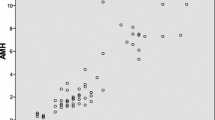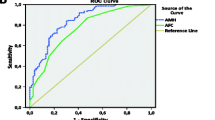Abstract
Purpose
To predict embryo/oocyte cryopreservation cycle (ECC) outcomes in breast cancer patients stimulated with letrozole and follicle stimulating hormone for fertility preservation based on observed anti-mullerian hormone (AMH) levels and antral follicle counts (AFC).
Methods
The correlation between AMH and AFC and ECC outcomes were analyzed retrospectively on forty one women with breast cancer before adjuvant treatment.
Results
AMH and AFC had a stronger correlation with the total number of oocytes and the number of mature oocytes than age, FSH, and inhibin B. Subjects were evaluated by the number of mature oocytes retrieved to create cutoff points of AMH level, which identified 1.2 ng/mL as a potential value. Seven of 18 patients with AMH levels ≤1.2 ng/mL had low response versus none of 23 with >1.2 ng/mL, (p = 0.001).
Conclusions
AMH is the most reliable serum marker of ECC outcomes, together with AFC as a biophysical marker, in breast cancer patients. Low response is highly likely when the AMH level is ≤1.2 ng/mL.

Similar content being viewed by others
References
Weir HK, Thun MJ, Hankey BF, Ries LA, Howe HL, Wingo PA, et al. Annual report to the nation on the status of cancer, 1975–2000, featuring the uses of surveillance data for cancer prevention and control. J Natl Cancer Inst. 2003;95:1276–99.
Smigal C, Jemal A, Ward E, Cokkinides V, Smith R, Howe HL, et al. Trends in breast cancer by race and ethnicity: update 2006. CA Cancer J Clin. 2006;56:168–83.
Oktay KH, Yih M. Preliminary experience with orthotopic and heterotopic transplantation of ovarian cortical strips. Semin Reprod Med. 2002;20:63–74.
Jemal A, Murray T, Samuels A, Ghafoor A, Ward E, Thun MJ. Cancer statistics, 2003. CA Cancer J Clin. 2003;53:5–26.
Ganz P, Hahn E. Implementing a survivorship care plan for patients with breast cancer. J Clin Oncol. 2008;26:759–67.
American Cancer Society: Breast Cancer Facts & Figures 2005–2006. http://www.cancer.org/downloads/STT/CAFF2005BrFacspdf2005.pdf
Sonmezer M, Oktay K. Fertility preservation in young women undergoing breast cancer therapy. Oncologist. 2006;11(5):422–34.
Azim AA, Costantini-Ferrando M, Oktay K. Safety of fertility preservation by ovarian stimulation with letrozole and gonadotropins in patients with breast cancer: a prospective controlled study. J Clin Oncol. 2008;26(16):2630–5.
Oktay K, Kim JY, Barad D, Babayev SN. Association of BRCA1 mutations with occult primary ovarian insufficiency: a possible explanation for the link between infertility and breast/ovarian cancer risks. J Clin Oncol. 2010;28(2):240–4.
Lohrisch C, Paltiel C, Gelmon K, Speers C, Taylor S, Barnett J, et al. Impact on survival time from definitive surgery to initiation of adjuvant chemotherapy for early-stage breast cancer. J Clin Oncol. 2006;24:4888–94.
Cold S, During M, Ewertz M, Knoop A, Moller S. Does timing of adjuvant chemotherapy influence the prognosis after early breast cancer? Results of the Danish Breast Cancer Cooperative Group (DBCG). Br J Cancer. 2005;93:627–32.
Lee MM, Donahoe PK, Hasegawa T, Silverman B, Crist GB, Best S, et al. Mullerian inhibiting substance in humans: normal levels from infancy to adulthood. J Clin Endocrinol Metab. 1996;81:571–6.
Seifer DB, MacLaughlin DT, Christian BP, Feng B, Shelden RM. Early follicular serum mullerian-inhibiting substance levels are associated with ovarian response during assisted reproductive technology cycles. Fertil Steril. 2002;77:468–71.
van Rooij IA, de Jong E, Broekmans FJ, Looman CW, Habbema JD, te Velde ER. High follicle-stimulating hormone levels should not necessarily lead to the exclusion of subfertile patients from treatment. Fertil Steril. 2004;81:1478–85.
Akman MA, Erden HF, Tosun SB, Bayazit N, Aksoy E, Bahceci M. Comparison of agonistic flare-up-protocol and antagonistic multiple dose protocol in ovarian stimulation of poor responders: results of a prospective randomized trial. Hum Reprod. 2001;16(5):868–70.
La Marca A, Broekmans FJ, Volpe A, Fauser BC, Macklon NS. ESHRE Special Interest Group for Reproductive Endocrinology—AMH Round Table: Anti-Mullerian hormone (AMH): what do we still need to know? Hum Reprod. 2009;24(9):2264–75.
van Rooij IA, Broekmans FJ, Scheffer GJ, Looman CW, Habbema JD, de Jong FH, et al. Serum antimullerian hormone levels best reflect the reproductive decline with age in normal women with proven fertility: a longitudinal study. Fertil Steril. 2005;83(4):979–87.
La Marca A, Sighinolfi G, Radi D, Argento C, Baraldi E, Artenisio AC, et al. Anti-Mullerian hormone (AMH) as a predictive marker in assisted reproductive technology (ART). Hum Reprod Update. 2010;16(2):113–30.
Jayaprakasan K, Campbell B, Hopkisson J, Johnson I, Raine-Fenning N. Prospective, comparative analysis of anti-mullerian hormone, inhibin B, and three-dimensional ultrasound determinants of ovarian reserve in the prediction of poor response to controlled ovarian stimulation. Fertil Steril. 2010;93(3):855–64.
Lekamge DN, Barry M, Kolo M, Lane M, Gilchrist RB, Tremellen KP. Anti-mullerian hormone as a predictor of IVF outcome. Reprod Biomed Online. 2007;14(5):602–10.
Kwee J, Schats R, McDonnell J, Themmen A, de Jong F, Lambalk C. Evaluation of anti-mullerian hormone as a test for the prediction of ovarian reserve. Fertil Steril. 2008;90:737–43.
Ebner T, Sommergruber M, Moser M, Shebl O, Schreier-Lechner E, Tews G. Basal level of anti-Mullerian hormone is associated with oocytes quality in stimulated cycles. Hum Reprod. 2006;21:2022–6.
Hazout A, Bouchard P, Seifer DB, Aussage P, Junca AM, Cohen-Bacrie P. Serum antimullerian hormone/mullerian-inhibiting substance appears to be a more discriminatory marker of assisted reproductive technology outcome than follicle-stimulating hormone, inhibin B, or estradiol. Fertil Steril. 2004;82:1323–9.
Silberstein T, MacLaughlin DT, Shai I, Trimarchi JR, Lambert-Messerlian G, Seifer DB, et al. Mullerian inhibiting substance levels at the time of HCG administration in IVF cycles predict both ovarian reserve and embryo morphology. Hum Reprod. 2006;21:159–63.
Cupisti S, Dittrich R, Mueller A, Strick R, Stiegler E, Binder H, et al. Correlations between anti-Mullerian hormone, inhibin B, and activin A in follicular fluid in IVF/ICSI patients for assessing the maturation and developmental potential of oocytes. Eur J Med Res. 2007;12:604–8.
Nelson SM, Yates RW, Lyall H, Jamieson M, Traynor I, Gaudoin M, et al. Anti-Mullerian hormone-based approach to controlled ovarian stimulation for assisted conception. Hum Reprod. 2009;24:867–75.
Guerif F, Lemseffer M, Couet ML, Gervereau O, Ract V, Royere D. Serum antimullerian hormone is not predictive of oocytes quality in vitro fertilization. Ann Endocrinol (Paris). 2009;70(4):230–4.
Freeman EW, Gracia CR, Sammel MD, Lin H, Lim LC, Strauss 3rd JF. Association of anti-mullerian hormone levels with obesity in late reproductive-age women. Fertil Steril. 2007;87(1):101–6.
Broer SL, Mol BW, Hendriks D, Broekmans FJ. The role of antimullerian hormone in prediction of outcome after IVF: comparison with the antral follicle count. Fertil Steril. 2009;91:705–14.
Acknowledgments
This study is partially supported by NIH HD 053112.
Author information
Authors and Affiliations
Corresponding author
Additional information
Capsule
AMH and AFC are the most reliable serum and biophysical markers of embryo/oocyte cryopreservation cycle outcomes in breast cancer patients stimulated with letrozole and follicle stimulating hormone.
Rights and permissions
About this article
Cite this article
Lee, S., Ozkavukcu, S., Heytens, E. et al. Anti-Mullerian hormone and antral follicle count as predictors for embryo/oocyte cryopreservation cycle outcomes in breast cancer patients stimulated with letrozole and follicle stimulating hormone. J Assist Reprod Genet 28, 651–656 (2011). https://doi.org/10.1007/s10815-011-9567-z
Received:
Accepted:
Published:
Issue Date:
DOI: https://doi.org/10.1007/s10815-011-9567-z




